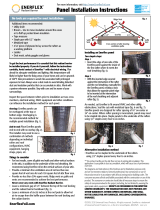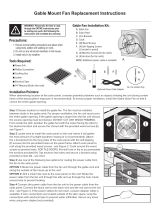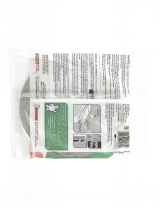Page is loading ...

Decrease your utility bills.
Increase the comfort of your home.
Reverso en español
15-Year Limited Warranty
Reduce energy usage
up to 15%
Tax credit eligible.
Save 10% up to $500.
Easy to install in your attic.
No tools needed.
ELIGIBILITY
UFP Western Division, Inc. (the “Warrantor”), is pleased to
extend this Warranty to you, the original consumer of the
Enerflex Radiant Barrier (the “product”). This Warranty is
valid for Enerflex Radiant Barrier material used in standard
residential dwellings and may not be assigned or
transferred by you.
15-YEAR LIMITED WARRANTY
Warrantor, at its option, will refund a percentage of the
purchase price or replace any Enerflex Radiant Barrier product
used in a residential application that exhibits defects in material
and workmanship that materially affect the ability of the product
to reduce solar heat transfer into a building space by radiation
within 15 years from the date of purchase.
This Warranty does not cover costs of installation, removal
or reinstallation. This Warranty does not cover any product
imperfections that do not affect the radiant barrier performance
of the product. Warrantor’s sole obligation is limited to
replacement of the Radiant Barrier product, and Warrantor
shall have no further liability or obligation except as expressly
stated herein. The Warrantor may elect to refund the
percentage of the original purchase price listed on the
Prorated Warranty Schedule in lieu of replacing the product.
Limitations on Warranty
The Warranty does not apply to any product that:
or other chemical or biological factors.
installation guidelines and local building codes.
abnormal residential use conditions.
manner other than as intended by Warrantor.
Failure to follow any restrictions or warnings supplied with
the product shall make the Warranty null and void and of no
further effect. Warrantor reserves the right to investigate any
claim and to inspect the materials for which a claim is made.
The Consumer assumes all risk and liability associated with
the construction or use of this product.
The Consumer or contractor should take all
necessary steps to ensure the safety of everyone involved
appropriate safety equipment.
CLAIM PROCEDURE
To make a claim under this Warranty to receive replacement
product, the original owner must, within ninety (90) days of
actual or constructive notice of damage covered by this
Warranty, do the following:
(1) Prepare a letter that includes the following information:
(a) A list of the number of pieces and the size of each
piece for which the claim is made.
(b) Proof of Purchase of the product, as shown on the
original invoice.
(c) Proof of Warranty, as evidenced by the original end-tag
from the product, or a copy of the mark on the product.
(2) Mail the above information to:
UFP Western Division, Inc.
Warranty Information
2801 East Beltline NE
Some states do not allow limitations on how long an implied
warranty lasts and/or do not allow the exclusion of incidental or
consequential damages, so the above limitations and exclusions
rights, and you may also have other rights that vary from state
to state.
Prorated Warranty Schedule
Percent of Purchase Price Covered
EnerflexFoil.com
©2009-2011 Universal Forest Products. All rights reserved.
Enerflex is a trademark of Universal Forest Products, Inc., in the U.S.
Made in USA.
5582-915_2/11
EnerflexFoil.com

The increased performance of your insulation and
ductwork and decreased workload on your air conditioner
and other appliances mean Enerflex Radiant Barrier will
pay for itself in utility bill savings.
Multiple studies and tests have proven the merits of
installing a radiant barrier system. For more information
on radiant barriers and their use, please visit the
Web sites below:
U.S. Department of Energy: www.energy.gov
Oak Ridge National Laboratory: www.ornl.gov
Florida Solar Energy Center: www.fsec.ucf.edu
Installing Enerflex Radiant Barrier in certain applications
may qualify for state and local government tax credits.
Many energy companies also offer rebates to their customers
your area to take advantage of these savings.
system will depend upon the climate, the type and size of
your house, the amount of insulation already in your house,
and your fuel use patterns and family size. To get the best
performance, it is essential that Enerflex Radiant Barrier
be properly installed.
Reduce your utility bills.
Enerflex Radiant Barrier reduces heat transfer
by thermal radiation across the air space
between your roof and the attic floor, where
insulation is typically installed.
On a hot day, heat from the sun is absorbed by the roof
shingles and warms up the sheathing below, which radiates
heat toward the attic floor and conventional insulation.
All materials emit radiant heat to varying degrees based
on their surface temperature. By installing Enerflex Radiant
back toward the roof.
The result: The top surface of the insulation is cooler than
it would have been, which reduces the amount of heat that
moves through the insulation to the living areas below.
Enerflex Radiant Barrier comes in flat panels and rolls to
Enerflex Rolls
Stapled to rafters
Best for new construction
and covering the gable
end walls and other
vertical surfaces
Roll sizes available
Larger roll sizes available
at EnerflexFoil.com
Enerflex Panels
Install without tools
Best for adding a radiant
barrier to an existing home
Panel sizes available
rafter spacing
rafter spacing
With
Radiant Barrier
Without
Radiant Barrier
Up to
30°
cooler
Pitch
Roof Pitch
Factor
2:12 1.02
5:12 1.08
1.12
8:12 1.20
*Measure this distance.
*
table 1
Example
A)
including attached garage
(if applicable)
B) Roof pitch 5:12
C) Roof pitch factor from
table 1
1.08
D) A x C
=
E) Rafter spacing
F) D
÷
rafters
÷
8
=
G) D
÷
on-center rafters
H) Total needed
I) Cost each
J) Total
table 2
Measuring your roof’s pitch
Determine the amount of Enerflex Radiant
Barrier panels needed
Installation option 1:
Installing panels between the rafters
The amount of Enerflex Radiant Barrier needed is equal
to take the measurement. To estimate the roof area,
think of your home as a basic square or rectangle.
Installation option 2:
Stapling to underside of rafters
If you intend to staple the radiant barrier to the
underside of the roof rafters, you need to know the
roof area square footage, calculated as follows:
1. Multiply the length and width of the attic to
2. Based on the pitch of your roof, multiply the
footprint square footage by the appropriate
factor listed in table 1.
The resulting number is the roof area square footage.
square footage amount, keeping in mind that each
radiant barrier piece is to be overlapped by 1-2 inches.
Note: If you have a gambrel or hip roof, you will
need to measure each section separately using
this technique and add the amounts to get the
total roof area square footage. If you intend to
cover the gable ends as well (recommended),
don’t forget to include those in your calculations.
Note: Laying over attic floor
DO NOT lay Enerflex over the attic floor on top of
existing insulation.
This application is susceptible to dust accumulation,
which will cause loss of performance over time.
Need LEED?
points under EA 1 and MR 5.
Design, is an internationally recognized green
12
12
Increase the comfort of your home year-round
with Enerflex
™
Radiant Barrier.
*
/






